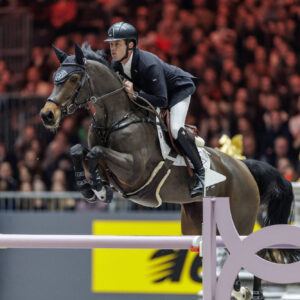Tendon and suspensory ligament injuries plague horses performing in all disciplines. Even pleasure horses and pasture ornaments may fall victim if they take the proverbial “bad step” over rough ground conditions. These are every bit as painful as bone or joint disorders and take as much as a year to heal.
Even when healing has progressed well these tissues are permanently weakened compared to their uninjured state, and always at risk of re-injury. Minor flare ups are common when horses are back in work. They may not have any serious lasting consequences, but they really take their toll in disrupted training schedules.
Fortunately, a little extra care can make a huge difference in terms of keeping previously injured areas tight and free of problems.
Use boots or wraps when working the horse. I don’t believe they really do much in terms of “supporting” the horse but they do help hold all the structures in correct alignment. If you have ever had a painful ligament or tendon you know how it is possible to use the involved structures (e.g. a wrist) without pain if you have a proper wrap in place.
Always ice the area for 30 minutes after work. Apply as soon as possible after exercise stops, even before removing tack or hosing. This sounds like a lot of work but once you get into a routine it becomes second nature. Bring preloaded ice wraps to the barn in an insulated carrier. Just swap them out as the ice melts.
Cold is very effective at curtailing minor inflammation but won’t interfere with the normal low level inflammatory processes needed for tissue maintenance and remodeling.
If the area tends to fill/swell when the horse stands still, use standing wraps when in the stall. The purpose is not to block the appearance of a sign of problems, but to prevent it from interfering with optimal circulation.
The above measures will not mask signs of serious re-injury but they will prevent or minimize discomfort from things like adhesions stretching or breaking down with exercise.
In terms of general management, movement is your friend in keeping all tissues as strong and flexible as possible so minimize stall time. Even a smallish paddock is better than standing still. Carefully condition the horse for the work you will be expecting and avoid fatigue at all costs.

©Flickr/MdAgDept
Whether shod or barefoot, absolutely meticulous attention to hoof trim and balance is critical to preserving the tissue repair. Working only over manicured surfaces is unrealistic but do avoid heavy going and slow down on uneven natural surfaces.
The common practice of giving a horse with an old injury phenylbutazone or other antiinflammatory/analgesic before work in anticipation of it stressing the area is not a good idea. If you are doing something that causes a reaction sufficient to require these drugs you shouldn’t be doing it in the first place. Work up to the desired level of performance gradually and if you consistently run into problems at a certain level of activity you will just have to accept the limitations or risk doing serious damage.
Tendons and ligaments are a specialized form of connective tissue, the most abundant tissue type in the body which also accounts for over 50% of the body’s protein yet little attention is paid to the role of nutrition. Lysine is the major essential amino acid in connective tissue, as well as its derivative hydroxylysine. Vitamin C is required for that conversion. Copper, a very common deficiency, is needed for the formation of strong reinforcing cross-links in the structure of tendons and ligaments. Although its exact role is unclear, magnesium is important to integrity of these tissues. Use of the quinolone antibiotics which can tie up magnesium is associated with side effects of tendon/ligament damage that can be prevented with magnesium.
Necessity of vitamin C supplementation is questionable since the horse can manufacture vitamin C but making sure lysine, magnesium and copper are adequately supplemented is simply common sense and important to these horses. Couple with some simple management adjustments and you will maximize the chance of enjoying an athletic partnership with the horse.
All content is for informational purposes only. Contact your local veterinarian if you have any questions regarding the health of your animals.
About the Author
Dr. Eleanor Kellon is a renowned expert on equine nutrition and related health issues. She offers private nutritional consultations and online courses through Equine Nutritional Solutions. Find out more at www.drkellon.com, and read more of her articles at DrKhorsesense.com.

 July 28, 2017
July 28, 2017 



























